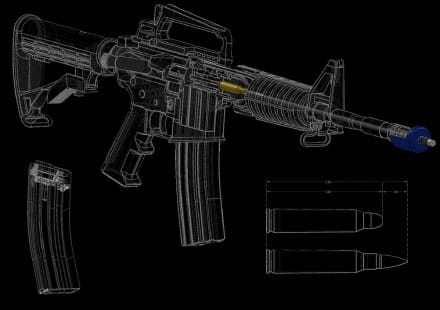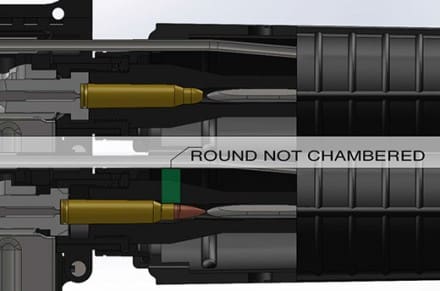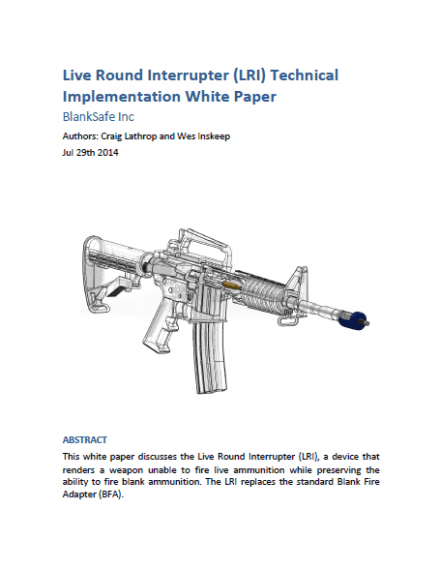The BlankSafe is a Live Round Interrupter intended to stop live rounds from fully chambering during training scenarios where blank rounds are in use. The BlankSafe LRI was developed by two US Navy SEALs who had personally witnessed multiple incidents where personnel under training conditions mistakenly loaded a live round during training. The LRI seats within the chamber of a rifle, allowing blank rounds to load and fire, however stopping live rounds from fully chambering.
The LRI causes a .27″ interrupt distance within the firing chain of an M4 rifle when a live round is loaded, preventing the weapon from firing.
Below is the White Paper for the BlankSafe LRI:
For more information, and to see videos of the BlankSafe Life Round Interrupter in action, visit www.blanksafe.com.
Tags: Blank Safe





Looks simple and effective – long overdue.
That “live round mixed in with the blanks” used to happen every single damn rotation at JRTC – despite all the controls in place to try to segregate ammo types, too many ways for a live mag to get into the mix of blanks. This is a much better insurance plan than just “hope they’re not aiming at a live person” when the BFA fails and the next round goes downrange.
Us Brits have magazines that have been adapted to take blank rounds, live rounds can be fitted into them but it takes a conscious physical effort to do so, they cannot be loaded by mistake.
These magazines are marked at factory with yellow initially just stripes but lately the whole mag.
Also the BFA used with the blank magazines on L85/L86 is rated to take IIRC 3 live rounds being fired into it before failing. It is a NATO standard thread so would fit onto M4/M16.
You have to use serious force to fit a live round into a blank mag (ie you would really notice the difference in force having to be used)
Together it makes a pretty good system. However, the main control should always be procedural not technology. Things like never going from live to blank during an exercise. Accepting it as “it happens sometimes” is an excuse for poor planning and drills for something potentially fatal.
I think the DOD uses the same standard. At least a couple of years ago when AAC was submitting a BFA that looked like one of their suppressors as part of a contract one of my friends working there said that was the standard that was stipulated.
This exact concept has been in use on Accuracy International .338 Lapua sniper rifles with the UK MOD for at least 5 years, perhaps longer. Very sound concept – glad it’s being adapted to more platforms.
Good idea. I remember my attached MG team setting up for a react to ambush drill only to see them whip out a belt of 4&1 from their “blanks”. Our retard of a Gunny requested live ammo for force on force training.
Same thing happened down here in NZ with some in camp trg. Started with a cut and paste error on the ammo demand, wrong NSN, right description. The young soldier on the gun at least had the nuts and common sense to ask if using live rounds in camp was the right thing.
I like the concept, but what is stoping this device from forcing the round back into the casing and therefore fully chambering and being able to fire
…with a very dangerous increase in pressure spike. With M855A1 already being dangerously hot as it is, this looks like a sure way to turn an M4 into a hand grenade, if bullet setback of that order should occur.
I think there are some serious possibilities for this. With minor adaptation, it could be set up for MGs as well, which tends to be where a lot of the mix-ups happen. Honestly, if this got forwarded to MACOMs, or DOD in general, it has the potential to save millions of dollars in equipment and time lost, as well as preventing injuries and/or deaths if the respective services got behind it. I know in TRADOC, this could have prevented two of the M4s here at Benning from exploding on ranges.
Interesting. We use a combination of a live-round inhibitor screw that serves the same function, a ported chamber that allows propellant gasses to vent into the hand guards if a live round is fired, and a magazine well block that only allows dedicated training magazines loaded with blank rounds to be inserted.